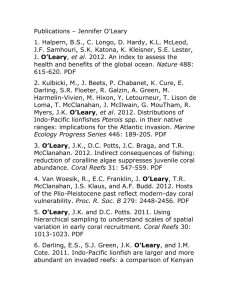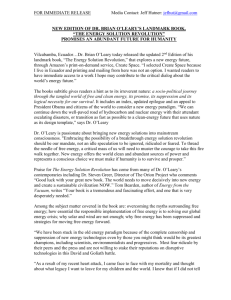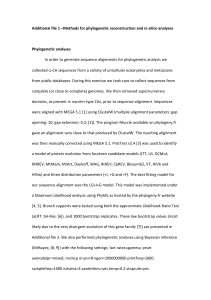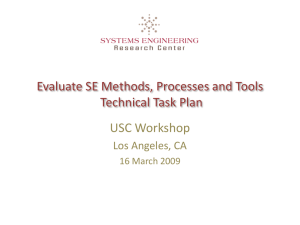864 52
advertisement
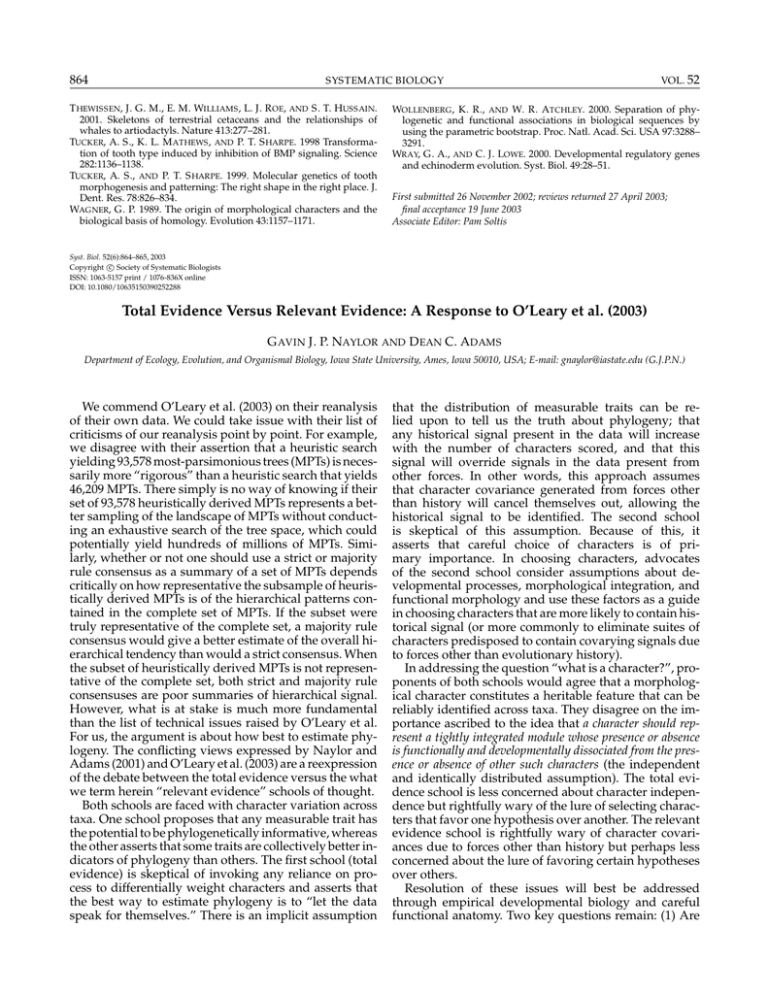
864
SYSTEMATIC BIOLOGY
T HEWISSEN, J. G. M., E. M. WILLIAMS , L. J. R OE, AND S. T. HUSSAIN.
2001. Skeletons of terrestrial cetaceans and the relationships of
whales to artiodactyls. Nature 413:277–281.
TUCKER, A. S., K. L. M ATHEWS , AND P. T. S HARPE. 1998 Transformation of tooth type induced by inhibition of BMP signaling. Science
282:1136–1138.
TUCKER, A. S., AND P. T. S HARPE. 1999. Molecular genetics of tooth
morphogenesis and patterning: The right shape in the right place. J.
Dent. Res. 78:826–834.
WAGNER, G. P. 1989. The origin of morphological characters and the
biological basis of homology. Evolution 43:1157–1171.
VOL. 52
WOLLENBERG , K. R., AND W. R. ATCHLEY. 2000. Separation of phylogenetic and functional associations in biological sequences by
using the parametric bootstrap. Proc. Natl. Acad. Sci. USA 97:3288–
3291.
WRAY, G. A., AND C. J. LOWE. 2000. Developmental regulatory genes
and echinoderm evolution. Syst. Biol. 49:28–51.
First submitted 26 November 2002; reviews returned 27 April 2003;
final acceptance 19 June 2003
Associate Editor: Pam Soltis
Syst. Biol. 52(6):864–865, 2003
c Society of Systematic Biologists
Copyright ISSN: 1063-5157 print / 1076-836X online
DOI: 10.1080/10635150390252288
Total Evidence Versus Relevant Evidence: A Response to O’Leary et al. (2003)
G AVIN J. P. NAYLOR AND D EAN C. ADAMS
Department of Ecology, Evolution, and Organismal Biology, Iowa State University, Ames, Iowa 50010, USA; E-mail: gnaylor@iastate.edu (G.J.P.N.)
We commend O’Leary et al. (2003) on their reanalysis
of their own data. We could take issue with their list of
criticisms of our reanalysis point by point. For example,
we disagree with their assertion that a heuristic search
yielding 93,578 most-parsimonious trees (MPTs) is necessarily more “rigorous” than a heuristic search that yields
46,209 MPTs. There simply is no way of knowing if their
set of 93,578 heuristically derived MPTs represents a better sampling of the landscape of MPTs without conducting an exhaustive search of the tree space, which could
potentially yield hundreds of millions of MPTs. Similarly, whether or not one should use a strict or majority
rule consensus as a summary of a set of MPTs depends
critically on how representative the subsample of heuristically derived MPTs is of the hierarchical patterns contained in the complete set of MPTs. If the subset were
truly representative of the complete set, a majority rule
consensus would give a better estimate of the overall hierarchical tendency than would a strict consensus. When
the subset of heuristically derived MPTs is not representative of the complete set, both strict and majority rule
consensuses are poor summaries of hierarchical signal.
However, what is at stake is much more fundamental
than the list of technical issues raised by O’Leary et al.
For us, the argument is about how best to estimate phylogeny. The conflicting views expressed by Naylor and
Adams (2001) and O’Leary et al. (2003) are a reexpression
of the debate between the total evidence versus the what
we term herein “relevant evidence” schools of thought.
Both schools are faced with character variation across
taxa. One school proposes that any measurable trait has
the potential to be phylogenetically informative, whereas
the other asserts that some traits are collectively better indicators of phylogeny than others. The first school (total
evidence) is skeptical of invoking any reliance on process to differentially weight characters and asserts that
the best way to estimate phylogeny is to “let the data
speak for themselves.” There is an implicit assumption
that the distribution of measurable traits can be relied upon to tell us the truth about phylogeny; that
any historical signal present in the data will increase
with the number of characters scored, and that this
signal will override signals in the data present from
other forces. In other words, this approach assumes
that character covariance generated from forces other
than history will cancel themselves out, allowing the
historical signal to be identified. The second school
is skeptical of this assumption. Because of this, it
asserts that careful choice of characters is of primary importance. In choosing characters, advocates
of the second school consider assumptions about developmental processes, morphological integration, and
functional morphology and use these factors as a guide
in choosing characters that are more likely to contain historical signal (or more commonly to eliminate suites of
characters predisposed to contain covarying signals due
to forces other than evolutionary history).
In addressing the question “what is a character?”, proponents of both schools would agree that a morphological character constitutes a heritable feature that can be
reliably identified across taxa. They disagree on the importance ascribed to the idea that a character should represent a tightly integrated module whose presence or absence
is functionally and developmentally dissociated from the presence or absence of other such characters (the independent
and identically distributed assumption). The total evidence school is less concerned about character independence but rightfully wary of the lure of selecting characters that favor one hypothesis over another. The relevant
evidence school is rightfully wary of character covariances due to forces other than history but perhaps less
concerned about the lure of favoring certain hypotheses
over others.
Resolution of these issues will best be addressed
through empirical developmental biology and careful
functional anatomy. Two key questions remain: (1) Are
2003
865
POINTS OF VIEW
the traits that are used as phylogenetic markers truly discrete, tightly integrated, and functionally autonomous
modules? (2) At what point is the error associated with
relaxing the severity of the criterion for a character significant enough to cause systematic error in phylogenetic
reconstruction? Answers to these questions will likely
vary from study to study and across systems. The debate is not new and is not one that will likely be settled with a few exchanges in the pages of Systematic
Biology. Nevertheless, we think it is one that has enduring
importance.
We are grateful for the opportunity provided by
O’Leary et al. (2003) to voice our perspective. We do
not expect the readership to come to a final resolution
favoring one view over another. However, for those interested, we simply recommend a rereading of O’Leary
and Geisler’s (1999) original paper, Naylor and Adams’s
(2001) reanalysis, and O’Leary et al.’s (2003) rejoinder
herein. We leave it to the readership to come to their
own conclusions.
R EFERENCES
NAYLOR, G. J. P., AND D. C. ADAMS . 2001. Are the fossil data really at
odds with the molecular data? Morphological evidence for Cetartiodactyla phylogeny reexamined. Syst. Biol. 50:444–453.
O’LEARY, M. A., J. G ATESY, AND M. J. NOVACEK . 2003. Are the fossil
data really at odds with the molecular data? Morphological evidence
for whale phylogeny (re)reexamined. Syst. Biol. 52:853–864.
O’LEARY, M. A., AND J. H. G EISLER . 1999. The position of Cetacea within
Mammalia: Phylogenetic analysis of morphological data from extinct
and extant taxa. Syst. Biol. 48:455–490.
First Submitted 10 June 2003; reviews returned 12 June 2003;
final acceptance 8 August 2003
Associate Editor: Chris Simon
Syst. Biol. 52(6):865–868, 2003
c Society of Systematic Biologists
Copyright ISSN: 1063-5157 print / 1076-836X online
DOI: 10.1080/10635150390252297
Matrix Representations with Parsimony or with Distances: Two Sides of the Same Coin?
FRANÇOIS -J OSEPH LAPOINTE,1 M ARK WILKINSON,2 AND D AVID B RYANT 3
1
Département de Sciences Biologiques, Université de Montréal, C.P. 6128, Succ. Centre-ville, Montréal, Québec H3C 3J7, Canada;
E-mail: lapoinf@biol.umontreal.ca
2
Department of Zoology, The Natural History Museum, Cromwell Road, London SW7 5BD, U.K.
3
Centre for Bioinformatics, McGill University, Lyman Duff Building, 3775 University, Montréal, Québec H3A 2B4, Canada
Matrix representation with parsimony (MRP) is a
method that takes as input a collection of source trees,
recodes them as binary matrices, and returns a tree that
is closest to the source trees using a parsimony criterion (Baum, 1992; Ragan, 1992). The average consensus
method, on the other hand, takes as input a collection
of weighted trees (i.e., with branch lengths) and uses a
matrix representation with distances (MRD) analysis to
seek the weighted tree that is closest to the source trees
using a least-squares criterion (Lapointe and Cucumel,
1997). MRP has been mostly used as an alternative to
data combination for assembling supertrees from source
trees bearing nonidentical but overlapping sets of leaves
(for reviews, see Sanderson et al., 1998; Bininda-Emonds
et al., 2002). The average procedure has also been employed to produce supertrees while taking into account
branch lengths (Lapointe and Kirsch, 2001). However,
both of these approaches can be used to combine source
trees with identical leaf sets, in the so-called consensus
setting (sensu Bininda-Emonds, 2003). In that particular
context, MRP and MRD represent two sides of the same
coin, and these methods are closely related consensus
techniques. Here, we briefly describe the coding and optimization steps of both approaches to identify their resemblances and differences, and we have used an example to illustrate the equivalence among those seemingly
different methods, in the consensus setting. Finally, we
note that the close relationship between MRP and MRD
may not hold in the supertree context.
CODING TREES FOR MRP
Given a rooted tree t representing the relationships
among a set of leaves (taxa) S = {1, . . . , n}, there exist a
variety of possible binary matrix representations m (e.g.,
Purvis, 1995; Ronquist, 1996; Wilkinson et al., 2001) corresponding to t. Here, we focus on the representation
originally introduced by Ragan (1992). We define a binary matrix m, with n rows representing the leaf set S of
t and p columns (or matrix elements, sensu Baum and
Ragan, 1993) representing the internal nodes of t. For
each such element of m, all terminal taxa (leaves) descending from the corresponding node are scored 1, and
all others are scored 0. To polarize the elements, an additional line is added to the matrix to represent an outgroup (or root) with all-zero values. A parsimony analysis of this binary matrix representation will recover the
corresponding tree it is encoding (Baum, 1992; Ragan,
1992) when zero-length branches, if there are any, are
collapsed. As a special case, a fixed number n of additional columns could be added to the matrix to represent
the terminal nodes of t, each one scored 1 for the corresponding taxon and 0 otherwise. These elements are
noninformative in a cladistic sense (i.e., they represent

